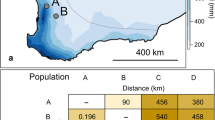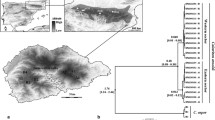Abstract
Theory suggests that parental relatedness is a continuous variable with a fitness optimum that we heretoforth will refer to as ‘optimal outbreeding’. In the present paper, we test this proposition from a conservation (translocation) perspective. Amphibians are facing a global decline and many amphibian populations are today small and threatened by extinction. Because genetic differentiation is often high between amphibian populations, they could be particularly sensitive to outbreeding depression, e.g. due to breakdown of locally adapted gene complexes. We tested if outbreeding would reduce fitness in common frogs, Rana temporaria, crossed from a large and an isolated, small population, separated by 130 km, using artificial fertilization. For females from the large population, tadpoles were significantly smaller and more malformed in crosses with males from the small population, than with males from the large population. For the small population, however, no significant paternal genetic effects could be found. The difference in response to outbreeding between populations was accompanied with significant differences in the importance of maternal effects. We conclude that care should be taken when translocating frogs between distantly related populations to avoid outbreeding depression.
Similar content being viewed by others
References
RA Alford SJ Richards (1999) ArticleTitleGlobal amphibian declines: a problem in applied ecology Annu. Rev. Ecol. Syst. 30 133–165
DN Alstad GF Edmunds (1983) ArticleTitleSelection, outbreeding depression, and the sex ration of scale insects Science 220 93–95
R Altwegg HU Reyer (2003) ArticleTitlePatterns of natural selection on size at metamorphosis in water frogs Evolution 57 872–882 Occurrence Handle12778556
W Amos A Balmford (2001) ArticleTitleWhen does conservation genetics matter? Heredity 87 257–265 Occurrence Handle10.1046/j.1365-2540.2001.00940.x Occurrence Handle1:CAS:528:DC%2BD38XitFegtA%3D%3D Occurrence Handle11737272
T Bataillon M Kirkpatrick (2000) ArticleTitleInbreeding depression due to mildly deleterious mutations in finite populations: size does matter Genet. Res 75 75–81 Occurrence Handle1:STN:280:DC%2BD3c3gsFSqtA%3D%3D Occurrence Handle10740923
P Bateson (1982) ArticleTitlePreferences for cousins in Japanese quail Nature 295 236–237
L Berger M Rybacki H Hotz (1994) ArticleTitleArtificial fertilization of water frogs Amphibia-Reptilia 15 408–413
KA Berven TA Grudzien (1990) ArticleTitleDispersal in the Wood frog (Rana sylvatica) - Implications for genetic population-structure Evolution 44 2047–2056
EG Brede TJC Beebee (2004) ArticleTitleContrasting population structures in two sympatric anurans: implications for species conservation Heredity 92 110–117 Occurrence Handle1:CAS:528:DC%2BD2cXms1antA%3D%3D Occurrence Handle14666130
AF Brown (1991) ArticleTitleOutbreeding depression as a cost of dispersal in the harpacticoid copepod, Tigriopus californicus Biol. Bull. 181 123–126
DA Driscoll (1998) ArticleTitleGenetic structure of the frogs Geocrinia lutea and Geocrinia rosea reflects extreme population divergence and range changes, not dispersal barriers Evolution 52 1147–1157
S Edmands (1999) ArticleTitleHeterosis and outbreeding depression in interpopulation crosses spanning a wide range of divergence Evolution 53 1757–1768
KL Gosner (1960) ArticleTitleA simplified table for staging anuran embryos and larvae with notes on identification Herpetologica 16 183–190
Hanski I, Simberloff D (1997) The metapopulation approach, its history, conceptual domain, and application to conservation. In: Metapopulation Biology: Ecology, Genetics, and Evolution (eds. Hanski I, Gilpin ME), pp. 5–26. Academic Press.
SP Hitchings TJC Beebee (1997) ArticleTitleGenetic substructuring as a result of barriers to gene flow in urban Rana temporaria (common frog) populations: implications for biodiversity conservation Heredity 79 117–127 Occurrence Handle9279008
B Keane (1990) ArticleTitleDispersal and inbreeding avoidance in the White-footed mouse, Peromyscus leucopus Anim. Behav. 40 143–152
LF Keller DM Waller (2002) ArticleTitleInbreeding effects in wild populations Trends Ecol. Evol. 17 230–241
KP Lampert AS Rand UG Mueller MJ Ryan (2003) ArticleTitleFine-scale genetic pattern and evidence for sex-biased dispersal in the tungara frog, Physalaemus pustulosus Mol. Ecol. 12 3325–3334 Occurrence Handle1:CAS:528:DC%2BD2cXks1yqsw%3D%3D Occurrence Handle14629349
AT Laugen A Laurila J Merilä (2002) ArticleTitleMaternal and genetic contributions to geographical variation in Rana temporaria larval life-history traits Biol. J. Linn. Soc. 76 61–70
A Laurila S Pakkasmaa J Merilä (2001) ArticleTitleInfluence of seasonal time constraints on growth and development of common frog tadpoles: a photoperiod experiment Oikos 95 451–460
FT Ledig (1986) Heterozygosity, heterosis, and fitness in outbreeding plants ME Soulè (Eds) Conservation Biology: The Science of Scarcity and Diversity Sinauer Associates Sunderland, MA 77–104
J Loman (2003) ArticleTitleGrowth and development of larval Rana temporaria: local variation and countergradient selection J. Herp. 37 595–602
T Madsen R Shine M Olsson H Wittzell (1999) ArticleTitleConservation biology – restoration of an inbred adder population Nature 402 34–35 Occurrence Handle1:CAS:528:DyaK1MXntlChtbg%3D
AB Marr LF Keller P Arcese (2002) ArticleTitleHeterosis and outbreeding depression in descendants of natural immigrants to an inbred population of song sparrows (Melospiza melodia) Evolution 56 131–142 Occurrence Handle11913658
RA Newman T Squire (2001) ArticleTitleMicrosatellite variation and fine-scale population structure in the wood frog (Rana sylvatica) Mol. Ecol. 10 1087–1100 Occurrence Handle1:CAS:528:DC%2BD3MXktFKitb4%3D Occurrence Handle11380868
GP Quinn MJ Keough (2002) Experimental Design and Data Analysis for Biologists Cambridge University Press UK
CJ Reading J Loman T Madsen (1991) ArticleTitleBreeding pond fidelity in the Common toad, Bufo bufo J. Zool. 225 201–211
HK Reinert (1991) ArticleTitleTranslocation as a conservation strategy for amphibians and reptiles: Some comments, concerns, and observations Herpetologica 47 357–363
K Räsänen A Laurila J Merilä (2003) ArticleTitleGeographic variation in acid stress tolerance of the moor frog, Rana arvalis. I. Local adaptation Evolution 57 352–362 Occurrence Handle12683531
RA Seigel CK Dodd (2002) ArticleTitleTranslocations of amphibians: proven management method or experimental technique? Conserv. Biol. 16 552–554
P Seppä A Laurila (1999) ArticleTitleGenetic structure of island populations of the anurans Rana temporaria and Bufo bufo Heredity 82 309–317 Occurrence Handle10336706
Shields WM (1993) The natural and unnatural history of inbreeding and outbreeding. In: The Natural History of Inbreeding and Outbreeding (ed. Thornhill NW), pp. 143–169. The University of Chicago Press.
F Ståhlberg M Olsson T Uller (2001) ArticleTitlePopulation divergence of developmental thermal optima in Swedish common frogs, Rana temporaria J. Evol. Biol. 14 755–762
AR Templeton (1986) Coadaptation and outbreeding depression ME Soulé (Eds) Conservation Biology: The Science of Scarcity and Diversity Sinauer Associates Sunderland, MA 105–116
PC Trenham DM Marsh (2002) ArticleTitleAmphibian translocation programs: reply to Seigel and Dodd Conserv. Biol. 16 555–556
DB Wake (1991) ArticleTitleDeclining Amphibian populations Science 253 860–860
RD Ward DOF Skibinski M Woodwark (1992) ArticleTitleProtein heterozygosity, protein-structure, and taxonomic differentiation Evol. Biol. 26 73–159 Occurrence Handle1:CAS:528:DyaK38XlvVKqt7c%3D
NM Waser MV Price (1989) ArticleTitleOptimal outcrossing in Ipomopsis aggregata – seed set and offspring fitness Evolution 43 1097–1109
Author information
Authors and Affiliations
Corresponding author
Rights and permissions
About this article
Cite this article
Sagvik, J., Uller, T. & Olsson, M. Outbreeding depression in the common frog, Rana temporaria. Conserv Genet 6, 205–211 (2005). https://doi.org/10.1007/s10592-004-7829-3
Issue Date:
DOI: https://doi.org/10.1007/s10592-004-7829-3




